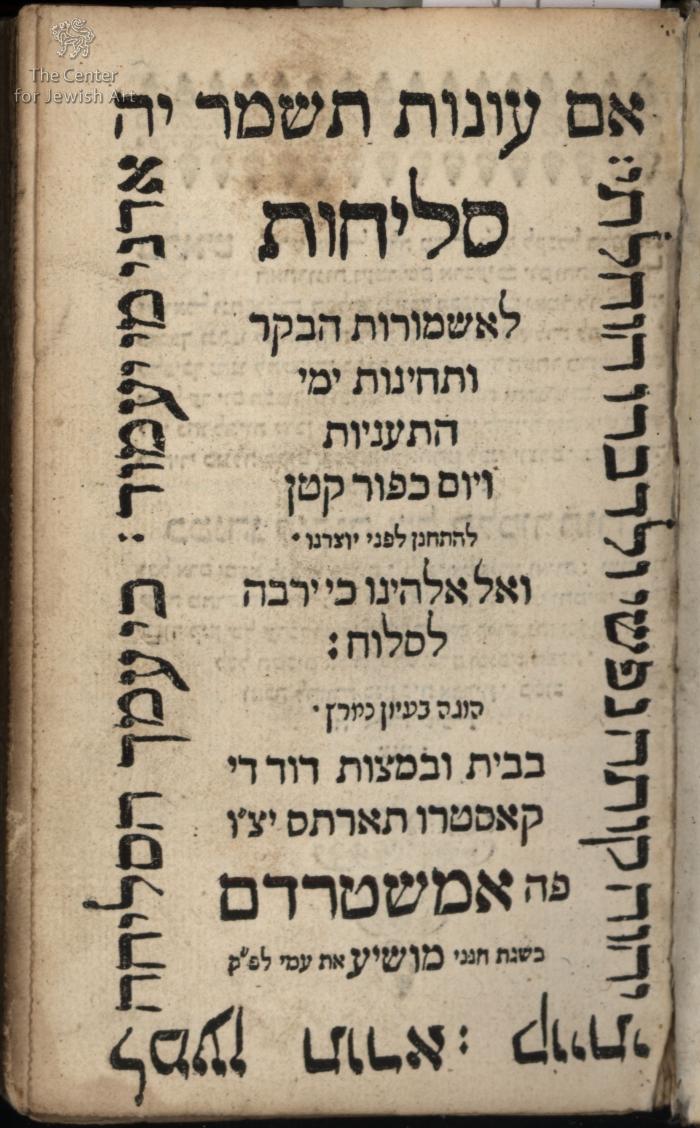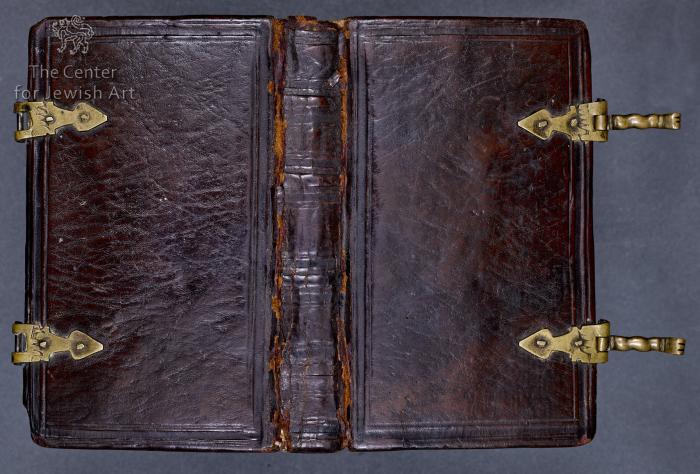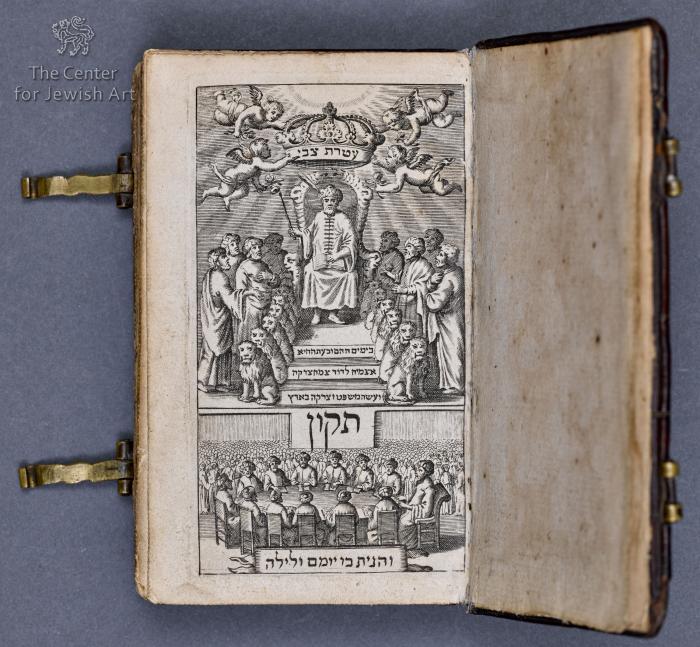Obj. ID: 35342 Tikkun Keriah by Nathan of Gaza, Amsterdam, 1666

sub-set tree:
The following description was prepared by William Gross:
Penitential prayers to be recited day and night, reputedly compiled by Nathan of Gaza (c.1643-1680), the prophet of Shabbetai Tzvi. This book contains one of the rarest of frontispieces in Jewish printing, explicitly showing the false messiah Shabbetai Tzvi seated on King Solomon’s throne.
Shabbetai Zvi was born in Smyrna in 1626, he showed early promise as a Talmudic scholar, and even more as a student and devotee of Kabbalah. More pronounced than his scholarship were his strange mystical speculations and religious ecstasies. He traveled to various cities, his strong personality and his alternately ascetic and self-indulgent behavior attracting and repelling rabbis and populace alike. He was expelled from Salonica by its rabbis for having staged a wedding service with himself as bridegroom and the Torah as bride. His erratic behavior continued. For long periods, he was a respected student and teacher of Kabbalah; at other times, he was given to messianic fantasies and bizarre acts. At one point, living in Jerusalem seeking "peace for his soul," he sought out a self-proclaimed "man of God," Nathan of Gaza, who declared Shabbetai Zvi to be the Messiah. Then Shabbetai Zvi began to act the part, as Gershom Scholem describes:
Riding around on horseback in majestic state [he] summoned a group of his followers, appointing them as apostles or representatives of the Twelve Tribes of Israel. The messianic news spread like wildfire to other communities in Palestine. First reports about Shabbetai Zvi reached Europe early in October 1665, containing detailed accounts. Much was mixed with legendary material and arrived as well in Italy, Holland, Germany and Poland. Messianic fervor took hold of communities that had no immediate experience of persecution and bloodshed as well as those which experienced such events. Repentance alternating with public manifestations of joy and enthusiasm was the order of the day. From many places delegations left bearing parchments signed by the leaders of the community which acknowledged him as the Messiah and king of Israel.
Not only did Shabbetai Zvi gain militant adherents in his native Turkey and in the Near East, but even in such cosmopolitan European cities as Venice, Livorno, and Amsterdam leading rabbis and sophisticated men of affairs were caught up in the messianic frenzy.
On September 15, 1666, Shabbetai Zvi, brought before the Sultan and given the choice of death or apostasy, prudently chose the latter, setting a turban on his head to signify his conversion to Islam, for which he was rewarded with the honorary title "Keeper of the Palace Gates" and a pension of 150 piasters a day. The apostasy shocked the Jewish world. Leaders and followers alike refused to believe it. Many continued to anticipate a second coming, and faith in false messiahs continued through the eighteenth century. In the vast majority of believers, revulsion and remorse set in and there was an active endeavor to erase all evidence, even mention of the pseudo-Messiah. Pages were removed from communal registers, and documents were destroyed. Few copies of the books that celebrated Shabbetai Zvi survived, and those that did have become rarities much sought after by libraries and collectors.
This collection of penitential prayers was reputedly compiled by Shabbetai Tzvi’s “prophet” Nathan of Gaza (c. 1643 – 1680), who sent it to Europe at the end of 1665. It was printed and reprinted in several locations and widely distributed. Many copies have two title pages, the first of which shows the now famous image of Shabbetai Tzvi holding a scepter, enthroned as Messiah on the throne of Solomon, beneath a crown inscribed, “A Crown of Glory” (“ateret tzvi”; Isaiah 28:5). The second, unillustrated, title page bears the date “Behold, I will save מושיע (426 = 1666) my people” (Zechariah 8:7), a clear allusion to Shabbetai Tzvi.
There are three editions of this tikkun printed by de Castro, all almost identical. The present edition also contains a Portuguese title page.
The tikkun was also printed in the same year in Amsterdam by Uri Fayvesh ha-Levi, also with an engraved title page, attesting to the great popularity of this work.
Following Shabbetai Tzvi’s conversion to Islam, most of the title pages bearing his image were ripped out of the books in which they had been bound. The present copy not only retains the title page, but is also bound with several different printed items of the time and of Shabbtaean interest. It is bound in a fine leather binding with silver clasps, reflecting the tastes of Amsterdam’s wealthy and cultured Sephardic citizens.144 pp.
David de Castro Tartas, active from 1662 - 1698, published close to 70 books in Hebrew and a number in other languages, primarily Spanish. He was the son of conversos who came to Amsterdam in 1640 via France where they returned to their ancestral faith. His brother Isaac, having gone to Racife and Bahia, was burned at an auto-de-fe in 1647, refusing to abjure his faith. David learned the printer's craft at the press of Menasseh Ben Israel, working there as a compositor. In 1662 he established his own press, in competition with the already-active presses of Uri Phoebus and Joseph Athias.
Shabbetai Zvi - group bound with NBH.109 and a Hebrew "Vidui Kaparah" (8 pages, 1666)







